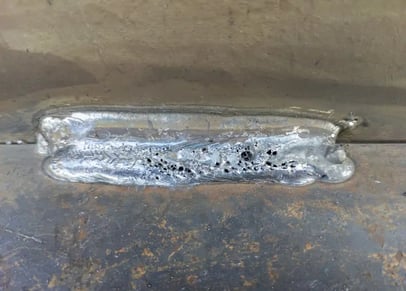Recognizing What is Porosity in Welding: Causes and Solutions
Recognizing What is Porosity in Welding: Causes and Solutions
Blog Article
Comprehending Porosity in Welding: Checking Out Reasons, Effects, and Prevention Techniques
As professionals in the welding market are well mindful, recognizing the reasons, impacts, and avoidance techniques associated to porosity is essential for achieving durable and reputable welds. By delving right into the root creates of porosity, analyzing its harmful results on weld high quality, and exploring reliable prevention strategies, welders can improve their knowledge and abilities to create high-quality welds continually.
Common Causes of Porosity
Porosity in welding is primarily triggered by a mix of elements such as contamination, incorrect shielding, and insufficient gas insurance coverage during the welding process. Contamination, in the kind of dirt, grease, or corrosion on the welding surface area, creates gas pockets when heated up, bring about porosity in the weld. Improper protecting takes place when the shielding gas, frequently utilized in procedures like MIG and TIG welding, is unable to completely protect the molten weld pool from reacting with the surrounding air, resulting in gas entrapment and succeeding porosity. Additionally, inadequate gas coverage, typically as a result of wrong flow prices or nozzle positioning, can leave components of the weld unprotected, allowing porosity to develop. These aspects jointly add to the formation of voids within the weld, deteriorating its honesty and possibly causing architectural problems. Understanding and resolving these usual causes are essential action in avoiding porosity and making sure the high quality and toughness of bonded joints.
Effects on Weld Top Quality
The visibility of porosity in a weld can dramatically endanger the general high quality and stability of the welded joint. Porosity within a weld develops voids or tooth cavities that damage the structure, making it more susceptible to breaking, rust, and mechanical failing. These voids act as stress and anxiety concentrators, minimizing the load-bearing capability of the weld and increasing the chance of early failure under used anxiety. Additionally, porosity can also function as prospective websites for hydrogen entrapment, more exacerbating the destruction of the weld's mechanical homes.
In addition, porosity can hinder the performance of non-destructive testing (NDT) strategies, making it challenging to identify other issues or interruptions within the weld. This can bring about substantial security problems, especially in essential applications where the architectural integrity of the welded components is extremely important.

Avoidance Techniques Summary
Given the damaging impact of porosity on weld top quality, effective avoidance techniques are critical to maintaining the architectural stability of welded joints. One of the key prevention strategies is comprehensive cleansing of the base products prior to welding. Contaminants such as oil, oil, corrosion, and wetness can add to porosity, so making certain a clean job surface area is vital. Proper storage of welding consumables in completely dry conditions is likewise critical to avoid dampness absorption, which can result in gas entrapment throughout welding. In addition, selecting the proper welding criteria, such as voltage, current, and travel speed, can assist decrease the risk of porosity formation. Making certain adequate protecting gas circulation and insurance coverage is another vital avoidance strategy, as insufficient gas coverage can cause atmospheric contamination and porosity. Appropriate welder training and qualification are crucial for implementing precautionary procedures effectively and consistently. By including these avoidance strategies into welding practices, the event of porosity can be dramatically reduced, resulting in stronger and much more reputable welded joints.
Significance of Proper Shielding
Correct shielding in welding plays a vital duty in protecting against climatic contamination and ensuring the integrity of welded joints. Protecting gases, such as argon, helium, or a mix of both, are generally made use of to secure the weld pool from responding with aspects in the air like oxygen and nitrogen. When these responsive elements enter contact with the hot weld swimming pool, they can cause porosity, causing weak welds with decreased mechanical residential or commercial properties.

Inadequate securing can lead to numerous problems like porosity, spatter, and oxidation, endangering the structural honesty of the bonded joint. Therefore, adhering to correct securing practices is necessary to produce top quality welds with marginal flaws and ensure the long life and reliability of the bonded components (What is Porosity).
Surveillance and Control Methods
How can welders successfully keep an eye on and regulate the welding you can try this out procedure to make certain optimum outcomes and prevent defects like porosity? By continuously keeping track of these variables, welders can identify discrepancies from the optimal conditions and make instant changes to prevent porosity formation.

Furthermore, carrying out appropriate training programs discover this for welders is necessary for keeping an eye on and managing the welding process efficiently. What is Porosity. Educating welders on the significance of preserving constant parameters, such as proper gas securing and take a trip speed, can help protect against porosity concerns. Routine evaluations and certifications can also make certain that welders excel in surveillance and managing welding processes
Furthermore, using automated welding systems can improve tracking and control capabilities. These systems can specifically control welding parameters, reducing the chance of human error and ensuring regular weld high quality. By combining sophisticated tracking modern technologies, training programs, and automated systems, welders can efficiently keep an eye on and control the welding procedure to minimize porosity issues and accomplish top notch welds.
Conclusion

Report this page